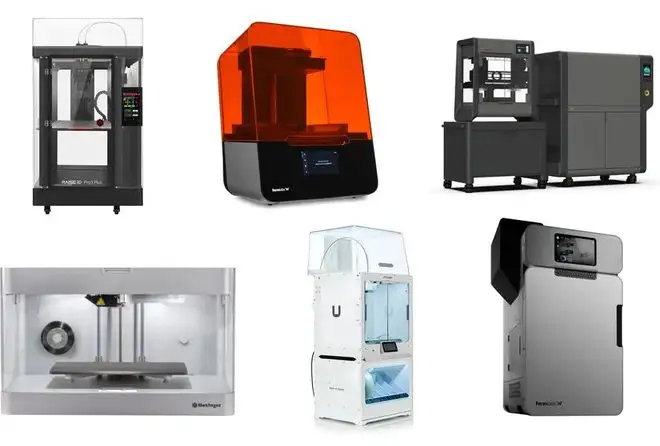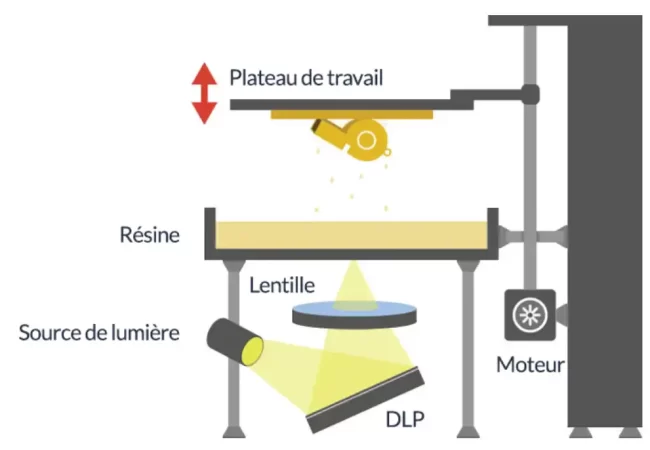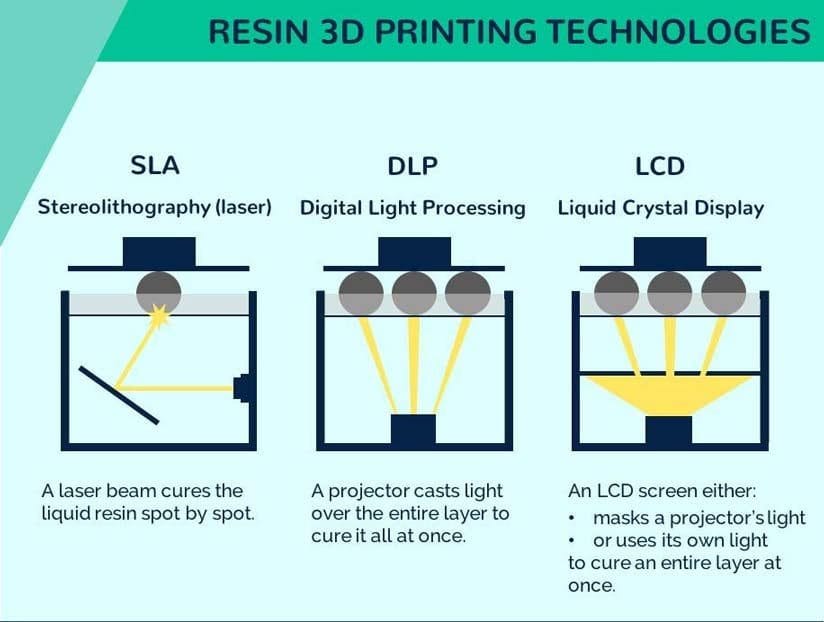With the mature development of 3D printing technology, various types of 3D printers have penetrated into the production life of people. Among them, light-curing resin 3D printers have become a popular choice for most people who want to make high-precision models for a variety of purposes, such as for companies, factories, creators, home use, and so on.
Nowadays, there are many kinds of stereolithography 3d printers on the market, so it becomes a problem to choose one. Next, we will introduce how to choose the right stereolithography 3d printers for you.

What are the main differences between SLA,DLP,LCD.
●SLA is the most traditional and widely used 3D printing technology that uses laser to cure resin, and has few restrictions on print size, but the print speed, accuracy and details are generally not as good as DLP / LCD 3D printers.

● DLP 3D printing technology first appeared in 2000. DLP 3D printing technology mainly uses UV projectors to project product cross-sectional graphics onto the surface of liquid photosensitive resin, causing the irradiated resin to be photocured layer by layer. Unlike SLA 3D printing technology with single point exposure, DLP 3D printing technology uses surface exposure, which can greatly improve the printing speed, and DLP 3D printing technology is generally better than SLA 3D printers in terms of accuracy and surface quality.

Most DLP 3D printers use a Top-down technology solution, where the light source is below the resin tank. The advantage of this solution is that very little resin is required to start printing, but the size of the print is also constrained due to the limitations of off-shape. DLP 3D printers are typically smaller models that can be easily deployed in office environments and are more widely used in dentistry, product development validation, research and education.
●LCD (mSLA) is similar to DLP 3D printing technology, but instead of using a projector to produce an image, it produces a specific image through the deflection of the LCD liquid crystal.

Benefit from the mature upstream chain of LCD 3D printing technology, LCD 3D printers can usually achieve higher resolution and smaller pixel dot size than DLP 3D printers. However, due to technical limitations, the optical power of LCD 3D printers is generally lower than that of DLP 3D printers, resulting in slower printing speeds. However, LCD 3D printers are more affordable than DLP 3D printers, making them very popular in the market.
What do we need to consider when choosing a resin 3D printer?
Print size (Devices with large format print size enable rapid iteration of design prototypes as well as rapid production of small batches.)
● Print accuracy (the higher the resolution and smaller the pixel dot size, the clearer the surface details and textures of the printed object; the more advanced the optical design, the higher the accuracy of the printed object and the ability to accurately render the design prototype.)
● Print speed (When evaluating print speed, we generally need to limit the material and layer thickness. Even on the same machine, different layer thicknesses and different materials can lead to huge differences in print speed.)
● Material openness (Some 3D printers only allow users to use dedicated resin materials, which is a very big limitation, while 3D printers with open systems are compatible to use more third-party materials.)
● Nesting/slicing software (Nesting and slicing is the first step in 3D printing, and a good software can make pre-processing fast and easy. (Most 3D printer companies offer free software trials that users can simply try before purchasing.)
● Post-processing (Resin 3D printed samples need to be cleaned and post-cured. Post-cured samples are stronger and less deformed. (Therefore, equipped with a complete cleaning machine and curing box can effectively improve efficiency and reduce labor cost.)
What types of applications are DLP and LCD technologies particularly suited for?
The first is in dental applications, where almost all dental applications can benefit from resin 3D printing, such as orthodontics, prosthetics and implants, with some of the top orthodontic braces manufacturers printing and making over 700,000 models per day. The second application is in product prototyping validation. Benefiting from advances in 3D printing materials, more and more engineers are using high-precision 3D printers in their offices for product prototyping. Resin 3D printers are ideal for rapid validation of product prototypes, and there are now many high-performance resin materials with performance comparable to ABS, PC or silicone rubber. While traditional outsourcing of prototyping can potentially involve waiting weeks, prototyping can be done in hours with resin 3D printers. The third application is in the direction of education. LCD and DLP 3D printers are often compact and easy to use, and more and more schools are using resin 3D printers for education or research. Jewelry is also an important application for resin 3D printing, where DLP and LCD 3D printing technologies can print very richly detailed features, even smaller than a hair. Many jewelry design studios are already using 3D printers and wax resins for product development.

Besides the printing equipment, what aspects need to be concerned when choosing resin materials?
The first concern is always safety. Although the photosensitive resin itself is very safe, MSDS (Material Safety Data Sheet) should be obtained from the manufacturer before purchasing the resin to deal with any possible surprises during use.
In addition there are so many different types of resin materials that we should choose the material according to the application. For example, rigid materials with low deformation should be chosen for dental model applications, while materials with good biocompatibility and toughness should be chosen for surgical guide applications.
The 3D printing industry is currently in a period of rapid development, and the products are gradually maturing, but because of the differences in product development, testing and quality control invested by different manufacturers, users may encounter a variety of problems in the process of use. Therefore, we should try to choose a company that has guaranteed quality and can provide good training and after-sales service to buy 3D printers.


